
Caryophyllaceae, commonly called the pink family or carnation family, is a family of flowering plants. It is included in the dicotyledon order Caryophyllales in the APG III system, alongside 33 other families, including Amaranthaceae, Cactaceae, and Polygonaceae. It is a large family, with 81 genera and about 2,625 known species.
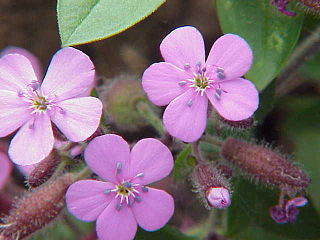
Saponaria is a genus of flowering plants in the family Caryophyllaceae, native to Asia and Europe, and are commonly known as soapworts. They are herbaceous perennials and annuals, some with woody bases. The flowers are abundant, five-petalled and usually in shades of pink or white. The genus is closely related to Lychnis and Silene, being distinguished from these by having only two styles in the flower. It is also related to Gypsophila, but its calyx is cylindrical rather than bell-shaped.

Silene dioica, known as red campion and red catchfly, is a herbaceous flowering plant in the family Caryophyllaceae, native throughout central, western and northern Europe, and locally in southern Europe. It has been introduced in Iceland, Canada, the US, and Argentina.
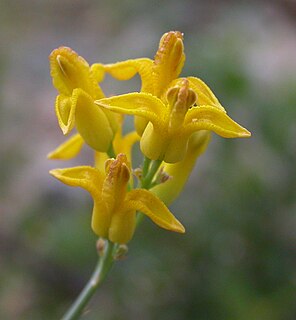
Ehrendorferia (eardrops) is a genus of two species of biennial or perennial herbaceous plants native to wildfire-prone areas of California and the Baja California peninsula. It was named after the Austrian botanist Friedrich Ehrendorfer on the occasion of his 70th birthday.
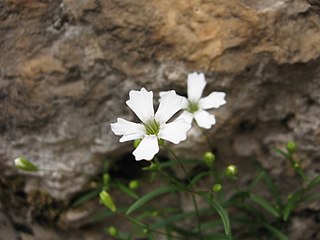
Heliosperma is a genus of flowering plants in the family Caryophyllaceae. As such, it is closely related to the large genus Silene, but its members can be told apart from Silene by the crest of long papillae on the seeds. The majority of the species are narrow endemics from the Balkan Peninsula, but H. alpestre is endemic to the Eastern Alps, and H. pusillum is found from the Cordillera Cantábrica in northern Spain to the Carpathians. Like members of the genus Silene and other related genera, Heliosperma is attacked by species of the anther smut fungus Microbotryum. Cases of parallel divergence events between alpine and mountain populations have been reported in this genus.

Silene conica is a species of flowering plant in the family Caryophyllaceae known by the common names striped corn catchfly and sand catchfly. It grows in dunes and sandy soils and is widespread in Europe and western Asia. It has an annual life history and produces self-compatible hermaphroditic flowers and occasional male-sterile flowers. Like other members of Silene section Conoimorpha, S. conica is readily recognizable based on its bright pink petals and the prominent, parallel veins on its calyx. In contrast to most flowering plants, S. conica appears to have a very rapid rate of mitochondrial mutation, and has the largest mitochondrial genome ever identified.
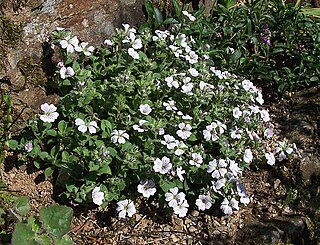
Acanthophyllum cerastioides, the chickweed baby's-breath, is a perennial plant of the family Caryophyllaceae, found in Bangladesh, Bhutan, North India, Nepal, North Pakistan and Sikkim, with a typical height of 10–27 cm. Recent molecular studies show this species is a member of genus Acanthophyllum rather than Gypsophila.

Silene samojedorum is a flowering plant in the family Caryophyllaceae.
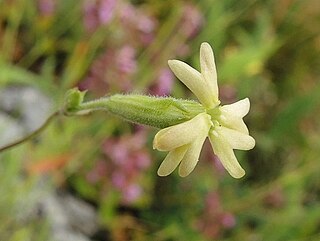
Silene flavescens are flowering plants part of the genus Silene, family Caryophyllaceae. They are widely distributed and are found in the northern hemisphere. They are native to Hungary and the Balkan Peninsula. It is an herbaceous species belonging to the tribe Sileneae

Silene otites, called Spanish catchfly, is a species of flowering plant in the genus Silene, native to Europe and the Transcaucasus area, and introduced to Xinjiang in China. It varies its floral odors to attract mosquitoes and moths at night and flies and bees by day. It is dioecious, with separate male and female plants.
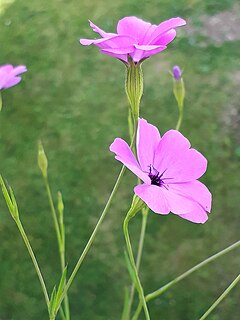
Eudianthe is a small genus of flowering plants in the family Caryophyllaceae, found in the Canary Islands and the western Mediterranean. It can be distinguished from other members of the tribe Sileneae by its linear to narrowly lanceolate leaves and its pink flowers.
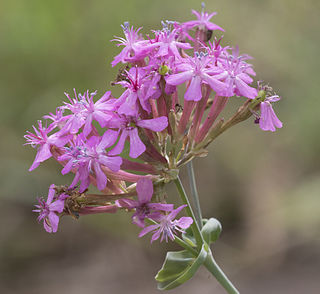
Atocion is a genus of flowering plants in the family Caryophyllaceae, tribe Sileneae, native to Europe, the Caucasus region, and the Middle East as far east as Iran. The species diversity is highest in the Balkans.
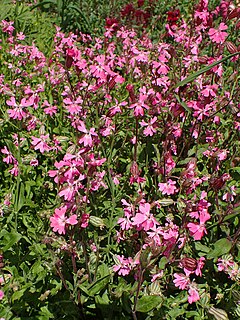
Silene pendula, called the nodding catchfly or drooping catchfly, is a species of flowering plant in the genus Silene, native to Italy, Greece, and Turkey, and introduced to scattered locations in North America, South America, Africa, Europe and Asia. A number of cultivars are available. A 2020 study showed with certainty that, despite their morphological similarities, Silene cisplatensis is not synonymous with Silene pendula.
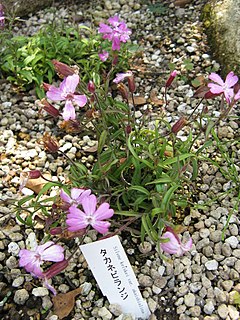
Silene keiskei is a species of flowering plant in the family Caryophyllaceae. The species is native to Japan (Honshu).

Silene mandonii is a species of flowering plant in the family Caryophyllaceae.
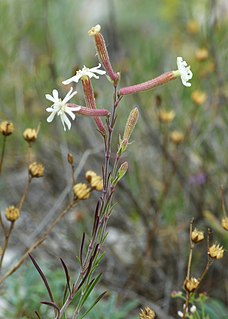
Silene supina is a species of flowering plant in the family Caryophyllaceae.

Silene sieboldii is a species of flowering plant in the family Caryophyllaceae. The species goes by the common name Chinese lychnis or jian chun luo.

Silene rubella is a species of flowering plant in the family Caryophyllaceae. In Italy the species goes by the common name silene rosseggiante.

Silene sedoides is a species of Silene. It is widely distributed across the Aegean Sea but one of its subspecies is endemic to Greece.


















